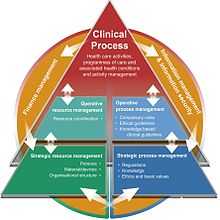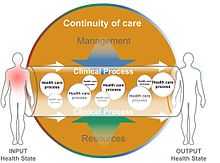System of concepts to support continuity of care
ContSys ( CEN standard EN13940[1]) defines a system of concepts to support continuity of care. Continuity of care is an organisational principle that represents an important aspect of quality and safety in health care. Semantic interoperability is a basic requirement for continuity of care. Concepts that are needed for these purposes must represent both the content and context of the health care services.
History of ContSys
The first part focusing on basic concepts was published as a European Norm in 2007. It was prepared by working group 2 of CEN TC251 - Health Informatics. Work to take the standard through ISO and to develop a second part focused on the healthcare process has proven problematic, resulting in the withdrawal of the two ISO work items on 13 January 2011[2] and a proposed resolution in CEN TC251 to stop the development of part 2 from CEN. A new work item is being developed in ISO Technical Committee 215 - Health Informatics aiming to bring a single concept model for both part 1 and the proposals for part 2.
Concept modelling
The concept models have been created according to ISO TR 24156. Concept modelling may be used for two purposes. The main purpose is to graphically describe a concept system within a subject field. This description can clarify the relationships between the concepts and illustrate some of their definitions. The other purpose is to let a concept modelling tool set up a data base organising the concept system, in order to keep track of its concepts and relationships, as well as check its consistency. Information modelling has the purpose of organising the information objects, each one representing knowledge about a concept. There is however additional information in an information model about the properties of the information objects, shown as attributes to the objects and operations describing behaviour of the objects.
Areas covered by the standard
The current ISO final draft of the standard has concepts covering the following activities:
- Healthcare actors
- Healthcare matters
- Activities
- Process
- Healthcare planning
- Time
- Responsibilities
- Information management
Areas not covered by the standard
The standard describes a system of concepts for the continuity of care. It does not provide an information model, record model or document structure. Some examples of these which should complement this standard are:
- Continuity of Care Record
- Continuity of Care Document
- EN ISO 13606 Health informatics - Electronic Health Record Communication and the related OpenEHR
- HL7 Clinical Document Architecture
- HL7 v3 Care Record Model
- Health Informatics Service Architecture
ContSys and the Clinical Process


The continuity of care is achieved in clinical processes. Continuity is influenced by factors of management and support. To cover continuity of care concepts from these basic process aspects are required:
- Core clinical process
- Management
- Support
Concepts for information and financial management to support continuity of care are also required. The relation between the business areas that have to be covered from continuity perspectives is used to structure this standard. The business areas are equivalent to areas of other perspectives e.g. information as well as IT functionality areas. The business model of the clinical process is focussed also in the information and the information support perspectives. The multiple perspectives of the areas may also include areas of groups of concepts in this standard.
Applications of ContSys
The NHS has published a model Draft NHS continuity of care concept model conforming to the committee draft of ContSys. ContSys has been shown by the NHS in England[3] to assist in business analysis by providing a model of how health care is organised.
The Swedish national e-health approach is using ContSys as a basis for harmonisation across standards.[4]
A number of governments are exploring the option of using ContSys as a harmonised concept model to enable their information models to be compatible.[5]
In the article "Modeling shared care plans using ContSys and openEHR to support shared homecare of the elderly."[6] the authors describe how the European Standard EN 13940-1 for continuity of care and the reference model of openEHR, were applied in modeling a shared care plan for shared homecare based on requirements from the OLD@HOME project. Their study shows that these requirements are matched by ContSys on a general level. However, certain attributes were not explicit in ContSys, for example agents responsible for performing planned interventions, and support for monitoring outcome of interventions. They further studied how the care plan conceptual model can be implemented using the openEHR reference model. The study demonstrates the feasibility of developing shared care plans combining a standard concept model, for example ContSys with an electronic health records (EHR) interoperability specification, that is the openEHR, while highlighting areas that need further exploration. It also explores the reusability of existing clinical archetypes as building blocks of care plans and the modeling of new shared care plan archetypes.
Conformance criteria
The conformance criteria in the committee draft have been substantially revised compared with the precursor standard.[1] The main focus of conformance defined in the committee draft[2] is on models and model driven systems however other International Standards may also conform to this standard. The criteria are summarised as:
- If the concept is used within a product it should be referred to using one of that concept's recognised names
- If one of the recognised names is used, the normative definition applies to that concept
- Conformance applies to that part of a product which overlaps the scope of ContSys
- Specialisations refine a concept - they do not extend a concept
- Multiplicities on associations between concepts can be constrained within the multiplicities defined in the standard
Current development timetable for the ISO standard
The current project aims to complete development of the ISO standard by May 2013 on a two year timetable. The key milestones are:
- Formally started the development in May 2011, following ISO/TC 215 plenary in Kuopio
- Completed Committee Draft[2] during September 2011 (three months later than intended) for submission for ballot in ISO/TC 215
- Committee draft approved for circulation as a proposed Draft International Standard in February 2012 in ISO/TC 215
- Complete Draft International Standard during June 2012 for submission for ballot in ISO/TC 215
- Draft Information Standard approved May 2013
- Complete Final Draft International Standard during winter 2014
- Publication spring 2015
See also
Notes
- ↑ 1.0 1.1 EN 13940-1:2007 Health informatics - System of concepts to support continuity of care - Part 1: Basic concepts. CEN 2007
- ↑ 2.0 2.1 2.2 ISO/CD 13940
- ↑ Presentation to ISO TC215 Working Groups 1, 3 and 8 in Kuopio, May 2011
- ↑ The use of Contsys in the Swedish national e-health approach
- ↑ Minutes of CEN TC251 WG1 meeting held 27 September 2011.
- ↑ J Am Med Inform Assoc. 2011 Jan-Feb;18(1):66-9. Epub 2010 Nov 24. Hägglund M, Chen R, Koch S.